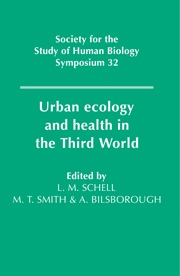Book contents
- Frontmatter
- Contents
- List of contributors
- Acknowledgements
- 1 Human biological approaches to the study of Third World urbanism
- 2 Social and cultural influences in the risk of cardiovascular disease in urban Brazil
- 3 The urban disadvantage in the developing world and the physical and mental growth of children
- 4 Differences in endocrine status associated with urban-rural patterns of growth and maturation in Bundi (Gende-speaking) adolescents of Papua New Guinea
- 5 Nutritionally vulnerable households in the urban slum economy: a case study from Khulna, Bangladesh
- 6 Urban-rural differences in growth and diarrhoeal morbidity of Filipino infants
- 7 Child health and growth in urban South Africa
- 8 From countryside to town in Morocco: ecology, culture and public health
- 9 Urban-rural population research: a town like Alice
- 10 Selection for rural-to-urban migrants in Guatemala
- 11 Health and nutrition in Mixtec Indians: factors influencing the decision to migrate to urban centres
- 12 Urban health and ecology in Bunia, N.E. Zaire, with special reference to the physical development of children
- 13 Food for thought: meeting a basic need for low-income urban residents
- 14 Immunological parameters in northeast Arnhem Land Aborigines: consequences of changing settlement patterns and lifestyles
- 15 Amerindians and the price of modernisation
- 16 Sex ratio determinants in Indian populations: studies at national, state and district levels
- 17 Polarisation and depolarisation in Africa
- 18 Urbanisation in the Third World: health policy implications
- Index
4 - Differences in endocrine status associated with urban-rural patterns of growth and maturation in Bundi (Gende-speaking) adolescents of Papua New Guinea
Published online by Cambridge University Press: 26 December 2009
- Frontmatter
- Contents
- List of contributors
- Acknowledgements
- 1 Human biological approaches to the study of Third World urbanism
- 2 Social and cultural influences in the risk of cardiovascular disease in urban Brazil
- 3 The urban disadvantage in the developing world and the physical and mental growth of children
- 4 Differences in endocrine status associated with urban-rural patterns of growth and maturation in Bundi (Gende-speaking) adolescents of Papua New Guinea
- 5 Nutritionally vulnerable households in the urban slum economy: a case study from Khulna, Bangladesh
- 6 Urban-rural differences in growth and diarrhoeal morbidity of Filipino infants
- 7 Child health and growth in urban South Africa
- 8 From countryside to town in Morocco: ecology, culture and public health
- 9 Urban-rural population research: a town like Alice
- 10 Selection for rural-to-urban migrants in Guatemala
- 11 Health and nutrition in Mixtec Indians: factors influencing the decision to migrate to urban centres
- 12 Urban health and ecology in Bunia, N.E. Zaire, with special reference to the physical development of children
- 13 Food for thought: meeting a basic need for low-income urban residents
- 14 Immunological parameters in northeast Arnhem Land Aborigines: consequences of changing settlement patterns and lifestyles
- 15 Amerindians and the price of modernisation
- 16 Sex ratio determinants in Indian populations: studies at national, state and district levels
- 17 Polarisation and depolarisation in Africa
- 18 Urbanisation in the Third World: health policy implications
- Index
Summary
Urban residence is frequently associated with increased growth and maturation. However, the mechanisms by which the urban environment affects growth and development are still not well understood. In this study, the role of steroid hormones in explaining urban-rural differences in adolescent growth is explored. One hundred and twenty-nine urban and 409 rural Bundi adolescents (aged between 10 and 24 years) were examined cross-sectionally in 1983–4. Growth status was assessed and serum samples were analysed for testosterone (T), dehydroepiandrosterone (DHEA) and its sulphate (DHEAS), androstenedione (A), oestrone (El), oestradiol (E2), and progesterone. Urban youths are significantly (p ≤ 0.05) taller and heavier, with greater body mass index than rural youths. These differences are greatest at younger ages and less or not significant at older ages. Comparable steroid secretory patterns were observed. Urban girls, 11–15 years old, have significantly greater steroid levels for all measures. For males, significant urban-rural differences are observed in the 16–20 year age range for D, DS, El, and A. At older ages, there are no urban-rural differences. Using stepwise regression analysis, endocrine measures (El, A, P) explained 54% of the variation in height for females. For males, T, El And/or E2, and A explained 65–76% of the variation in the growth status and urban residence explained a small (1%), but statistically significant, amount of additional variation. These findings suggest that earlier maturation is the most prominent feature of the growth of urban Bundi adolescents.
- Type
- Chapter
- Information
- Urban Ecology and Health in the Third World , pp. 38 - 60Publisher: Cambridge University PressPrint publication year: 1993
- 5
- Cited by



